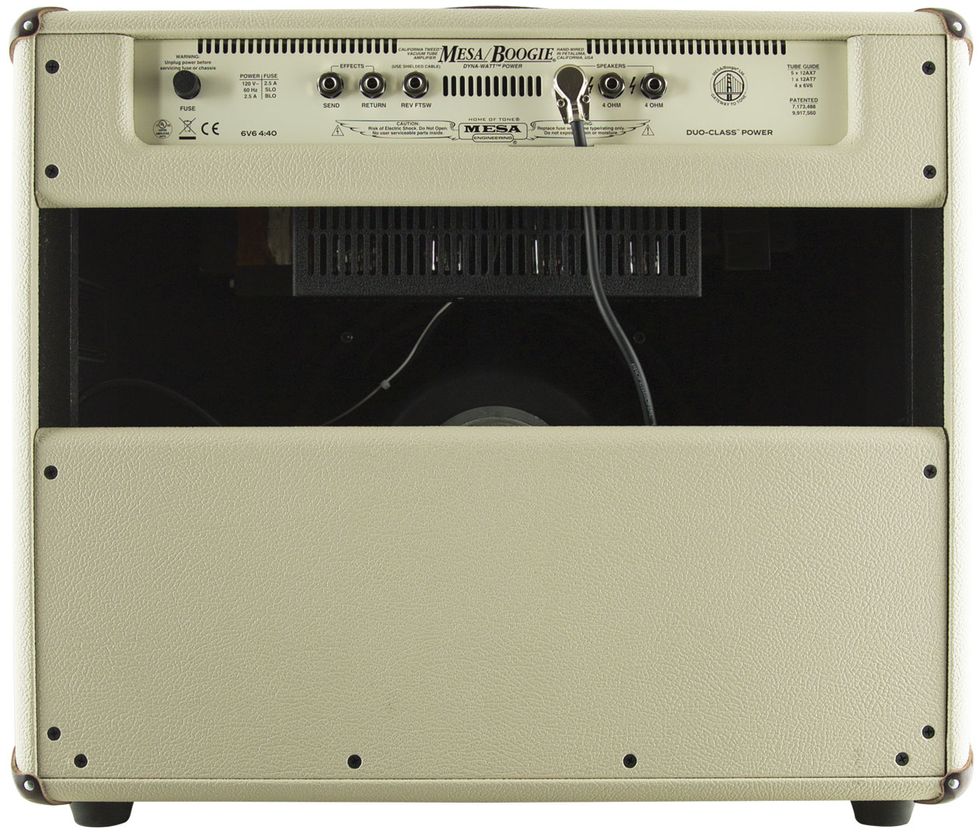RatingsPros:Superb sounds. Superb construction. Superb range. Superb everything. Cons: Weighs 49 pounds. No tremolo. Street: $1,899 Mesa/Boogie California Tweed mesaboogie.com | Tones: Ease of Use: Build/Design: Value: |
Let’s invert this review and put the conclusion up front: The California Tweed, Mesa’s new take on old Fender amp circuits, is simply stunning. It’s easily one of the best-sounding tweed-influenced amps I’ve ever encountered. Perhaps thebest.
A Need for Tweed?
Let’s face it: Fender’s 1950s tweed models can be problematic for modern guitarists. It’s easy to love their airy highs, cracking presence, and magnificent dynamic response. But their low end can be too loose and unfocused for contemporary tastes. Likewise, their tendency to get shrill at maximum volumes can alienate players who expect fatter, darker tones when they dime the volume. I suspect there are more than a few guitarists who fell in love with the lore of the tweed amp, only to encounter one in the flesh and find it a poor fit for their style.
In a nutshell, the California Tweed maintains the intensity and responsiveness of ’50s Fenders while updating other aspects for modern tastes. Lows are taut and focused. Cranking the gain yields smooth, warm overdrive. Also, Mesa has added a raft of cool modern features, capturing it all in an attractive and masterfully constructed 40-watt combo.
Fifty Shades of 6V6
The California Tweed employs a quartet of 6V6 power tubes. Historically, Fender used two of these in their midsized tweed amps, but relied on cleaner, glassier-sounding 6L6s in their 40-watt designs. But while Fender never made a 4 x 6V6 amp, the recipe has become so popular with boutique builders in recent years that it’s no longer an oddity. It’s a winning formula, in fact, providing the volume of a 6L6 model, but with warmer tones and smoother transitions from clean and crunch.
Here, Mesa deploys the tubes in an ingenious design featuring five power modes, selectable via a front-panel switch. In full-powered 40-watt mode, the tubes run in class A/B pentode mode. For 30 watts, one pair of tubes runs in A/B triode mode and the other runs in A/B pentode mode. In 20-watt mode, only a pair of tubes is used in pentode mode. The same two tubes run as triodes in 10-watt mode. And at two watts, the pair runs in class-A parallel mode: one tube wired pentode and the other triode.
Cast of Characters
The result is much more than a spiffy power attenuator. Triode wiring sounds distinct from pentode wiring, producing looser tones that have been described as “bluesy” and “sloppy,” depending on the player’s perspective. Pentode, triode, and pentode-plus-triode modes each have their own personality, and each responds differently to the gain control, so there is quite a cast of characters here. With this feature alone, Mesa boldly goes where no tweed has gone before.
The sensitivity and interactivity of the tone controls are reminiscent of 3-knob tone stacks on larger tweeds, such as the Bassman. Their voicing seems more manicured, however. There’s an additional variable: two input jacks. The “normal” input is loud and snappy, while “low” is cleaner with greater headroom. Their characteristics differ enough that I’d consider adding an A/B switch to change inputs on the fly.
If this all seems a bit complex, don’t sweat it. You have to work pretty hard to get a bad tone from the California Tweed. A final sonic sweet spot is an unusually smooth-and-rich-sounding spring reverb. (On/off pedal not included.) The speaker is a Jensen Blackbird, a recent 100-watt 12"alnico model that offers more headroom than a vintage Jensen while maintaining a retro Fender character. It’s nothing like those clean, clinical-sounding JBLs Fender used in some vintage models.

Blonde Bombshell
The California Tweed looks as lovely as it sounds. It’s garbed in “cream bronco” vinyl (custom vinyl colors are available), offset by a wheat-colored grille cloth, a handle and corner protectors of dark brown leather, and a pale metal faceplate. There’s even a blonde variation on Mesa’s usual silver-on-black logo plate. Hernia warning, though: This thing weighs a hefty 49 pounds.
The cabinetry is solid and flawlessly joined. Inside, components are arranged on a circuit board, with chassis-mounted pots. Mesa describes the amp as “handwired in the USA. And there’s much careful hand-wiring connecting the sections, plus daubs of glue to secure and separate the on-board components. You can tell that a skilled human being finalized this build.
Sparkle and Snarl
About the audio examples: The first clip features only the amp and an all-original 1963 Stratocaster. I wasn’t shy about using the potentially prickly bridge pickup, yet the tone never gets shrill. For the second clip, I switch to a DIY guitar with humbuckers, adding germanium overdrive at the input and plugging an Eventide H9 multi-effector and Strymon Volante delay into the rear-panel effects loop.
You hear various power, gain, and tone-control configurations, though at some point I just controlled the sound from the guitar’s pots. The California Tweed is exceedingly responsive to guitar volume knob adjustments. With the gain knob at 2 o’clock or so, you can go from chunk to low-noise sparkle directly from the guitar.
The Verdict
You read the verdict in paragraph one: The California Tweed kills. It’s got countless fine tones and no yucky ones. It augments the sparkle and sensitivity of vintage tweed amps with fuller lows, warmer high-gain sounds, and a wealth of tone-shaping tools. Granted, $1.9K ain’t chicken feed. But the amp’s tones, build, and features easily outdistance any number of costlier boutique models. California Tweed is both inspired and inspiring.
Watch the First Look:









![Rig Rundown: Russian Circles’ Mike Sullivan [2025]](https://www.premierguitar.com/media-library/youtube.jpg?id=62303631&width=1245&height=700&quality=70&coordinates=0%2C0%2C0%2C0)

















